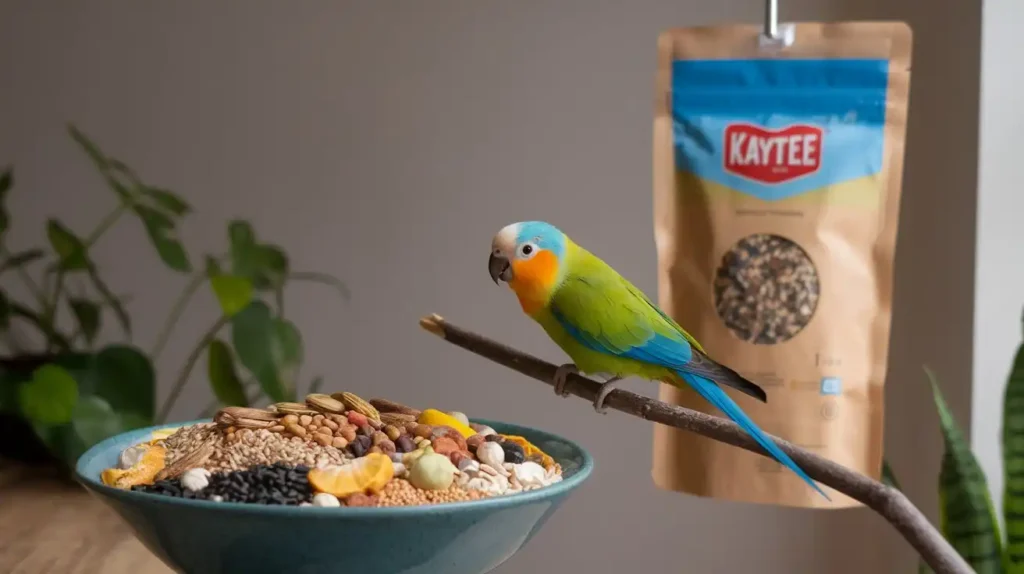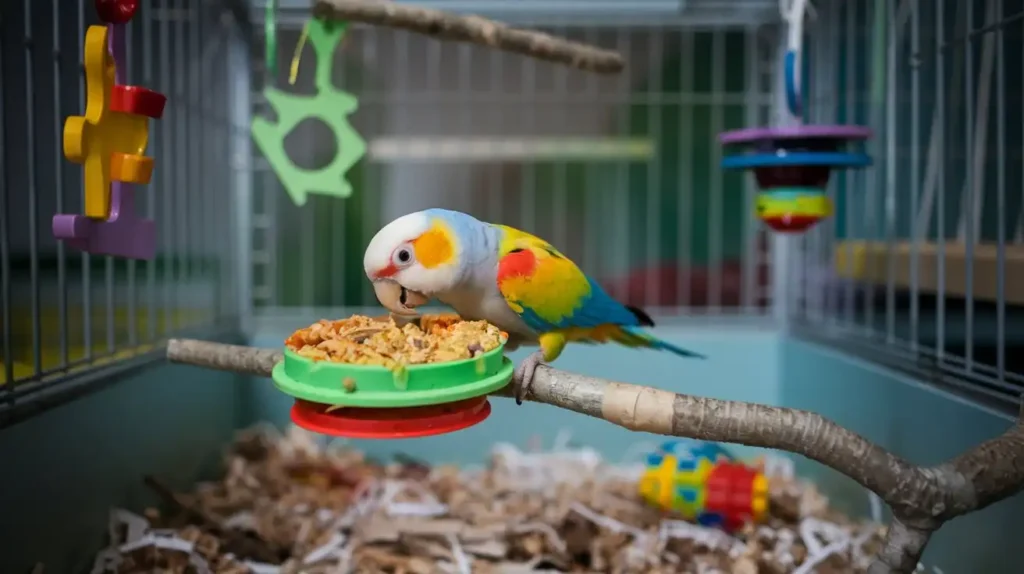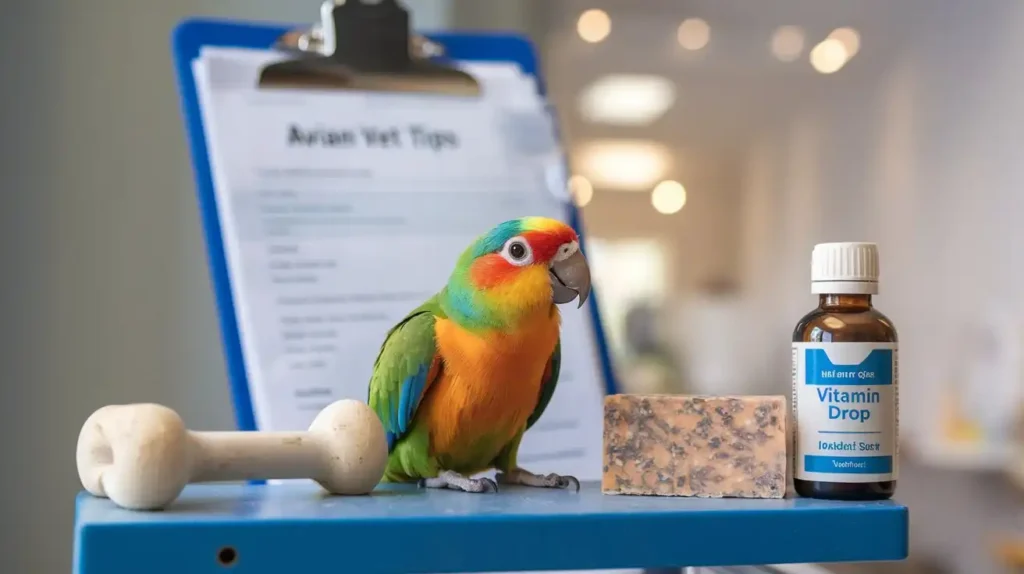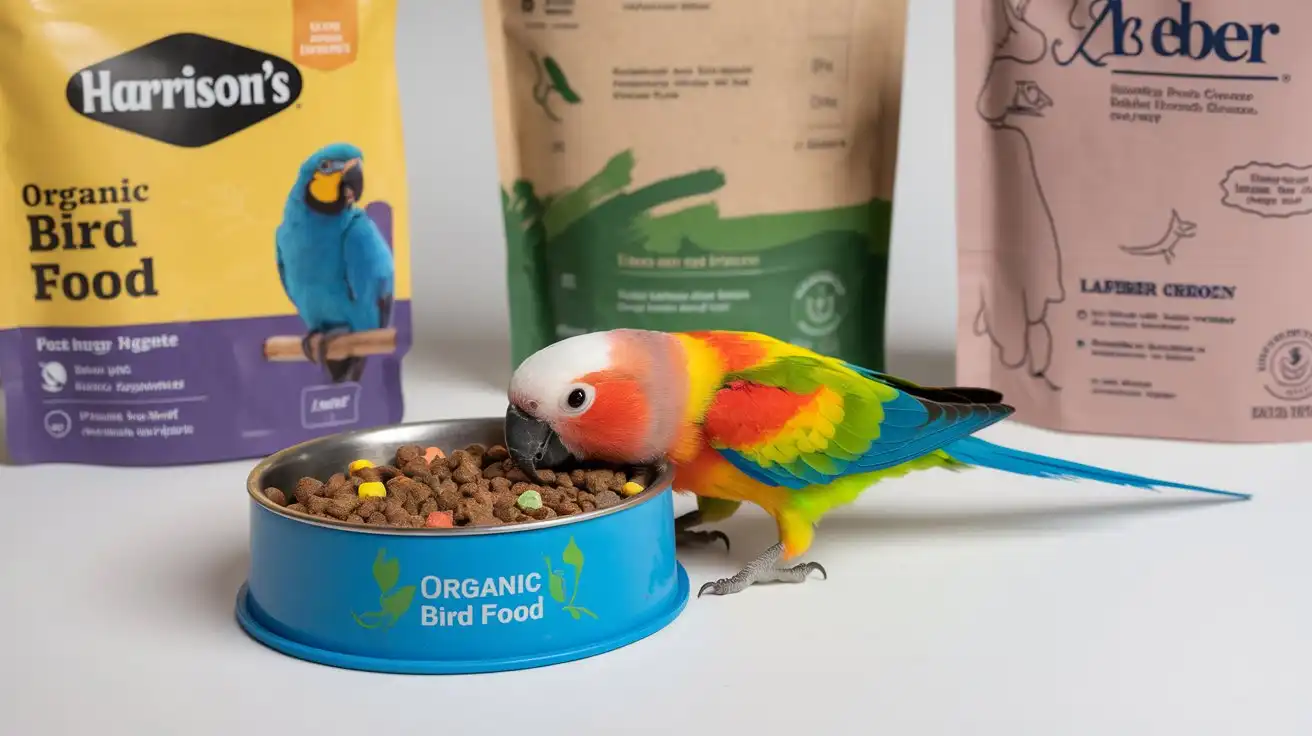Feeding your feathered friend the right diet can make all the difference in their health, happiness, and lifespan. Whether you’re caring for a Budgie, Lovebird, Parrotlet, or Cockatiel, knowing exactly what to put in their food bowl matters. That’s why we’ve created this Small Parrot Food List—a guide to help you choose the best and most nutritious options available.
Small parrots have fast metabolisms and high energy needs, which means they need more than just basic bird seed to thrive. A good diet should have different kinds of food. This includes pellets, seeds, fresh fruits, vegetables, and some fun snacks to find and eat. When you combine the right foods with proper feeding habits, you support their immune system, improve feather quality, and even boost their mood.
In this post, we’ll cover the five best food picks for small parrots, highlighting what makes each one essential. We’ll also share helpful feeding tips, brand recommendations, and safe food suggestions—everything you need to build a healthy and varied diet for your pet bird. Let’s dive into the delicious world of parrot nutrition!
High-Quality Parrot Pellets: The Foundation of a Healthy Diet
Harrison’s Adult Lifetime Fine Pellets
When it comes to premium nutrition, Harrison’s Adult Lifetime Fine Pellets is a standout choice for small parrot owners. Designed with the help of avian veterinarians, this pellet formula contains everything your bird needs to stay healthy without requiring additional supplementation. These pellets are USDA-certified organic and made with human-grade ingredients. That means you won’t find any artificial colors, preservatives, or chemical additives in the mix.
The fine texture makes them easy for small parrots like budgies, parrotlets, cockatiels, and lovebirds to eat. Their consistent size helps reduce food waste while encouraging proper chewing. One of the major benefits of Harrison’s is its ability to maintain feather condition, boost energy levels, and support immune function. Many pet parents report improvements in their bird’s behavior and physical appearance after switching to this food.
Because the formula is so complete, it’s often recommended as the main component of a Small Parrot Food List. It works especially well when supplemented with fresh vegetables and occasional fruit. Birds enjoy its nutty, natural flavor, and it’s easier to transition than many assume.
Store the pellets in a cool, dry place, and always use the resealable bag to maintain freshness. Introduce them slowly if your bird currently eats mostly seeds. Start by adding a little bit of the new food to what they usually eat. Then, slowly give them more over the next 10 to 14 days. With a little patience, Harrison’s can become the foundation of a balanced, vet-approved parrot diet.
ZuPreem FruitBlend for Small Birds
If your small parrot prefers colorful, flavorful food, ZuPreem FruitBlend for Small Birds might be the perfect match. This pellet-based diet combines essential nutrition with an enticing fruity aroma and bright colors that attract even the pickiest eaters. The small pellet size makes it easy for birds like lovebirds, budgies, cockatiels, and parrotlets to pick up and eat without struggle.
Every pellet is filled with the right amount of vitamins, minerals, and amino acids, and amino acids. These nutrients support daily health, including bone strength, vibrant feathers, and an active metabolism. ZuPreem’s formula includes ingredients like ground corn, soybean meal, and fresh fruit flavors, creating a familiar yet complete meal that parrots enjoy. You can use it as a main food source, ensuring your bird gets consistent nutrition in every bite.
The variety in shape and color also encourages natural foraging behavior, making mealtimes more mentally stimulating. Many parrot owners report that transitioning to ZuPreem improves their bird’s energy levels and appearance over time. It’s a smart way to introduce a structured, pellet-based routine while still giving your parrot something fun to look forward to each day.
When building your Small Parrot Food List, consider including ZuPreem as either a full diet or part of a rotation with other high-quality options. Pair it with fresh vegetables and fruits to enhance variety and keep your bird curious at the food bowl. Just remember to store it in an airtight container to preserve its freshness and flavor.
Lafeber Premium Daily Diet Pellets
If you want a healthy, vet-formulated food that small parrots actually enjoy eating, Lafeber Premium Daily Diet Pellets delivers on all fronts. These pellets combine the best of science and nature. They’re made in small batches in the USA using high-quality, non-GMO ingredients, and every batch goes through rigorous quality checks to ensure purity and consistency.
Lafeber pellets are different from many other bird foods because they include omega-3 and 6 fatty acids, which support brain health, heart function, and vibrant feathers. The balanced formula meets the daily nutritional needs of budgies, cockatiels, parrotlets, and other small parrots. These pellets help prevent common deficiencies that can occur with seed-only diets, such as low calcium or vitamin A.
Another standout feature is their crunchy texture and natural flavor. Many birds enjoy the consistency and taste, especially when you introduce the pellets gradually. The round shape encourages chewing and helps maintain beak strength. Unlike artificially colored pellets, Lafeber’s formula stays clean and natural without unnecessary additives.
You can safely use these pellets as the core of your bird’s diet. Mix in fresh fruits and vegetables for variety and to keep feeding time interesting. These pellets also pair well with foraging toys, adding an enrichment element to your bird’s day.
When creating a balanced Small Parrot Food List, Lafeber should definitely make the cut. It’s trusted by avian vets, easy to store, and most importantly—loved by birds.
Parrot Feeding Tips for Transitioning to Pellets
Switching your small parrot from seeds to pellets might seem challenging at first, but the right approach makes all the difference. Many small parrots develop strong preferences for seeds early on. To encourage healthy change, you need a gradual, stress-free transition. Start by offering a small portion of pellets alongside their regular food. Don’t remove the seeds right away—let them explore the new food without pressure.
Try different pellet textures, shapes, and flavors. Some birds prefer fruit-flavored pellets like ZuPreem, while others lean toward plain, natural options like Harrison’s. Offer moistened pellets if your parrot resists the dry ones. Warm water softens them and can release a more appealing aroma. Place pellets in a separate dish at first, and leave them for a few hours to give your bird time to try them.
You can also use feeding time to build curiosity. Eat some food in front of your bird and act like you are eating the bird’s pellets. Parrots often mimic behavior, especially from trusted humans. Praise your bird and offer small rewards when they show interest or take a bite. Stay patient and consistent—it may take days or even weeks for full acceptance.
Make sure to monitor weight and droppings during the transition to ensure your bird continues eating enough. Once your parrot starts eating pellets regularly, you can begin reducing seeds slowly.
Every healthy Small Parrot Food List should include quality pellets, but the transition must be respectful of your bird’s pace and personality.
Seed Mixes in Moderation: Tasty and Nutritious
Kaytee Forti-Diet Pro Health Bird Seed
Kaytee Forti-Diet Pro Health Bird Seed offers a complete blend of nutrients for small parrots.This seed mix helps birds have more energy, grow strong, and have healthy feathers. It is made from a good mix of grains, beans, and vitamins chosen for their health benefits. The mix contains essential fatty acids, antioxidants, and minerals that help strengthen your parrot’s immune system. Its formulation appeals to birds like budgies, cockatiels, lovebirds, and parrotlets. Each seed and grain works together to provide consistent energy while sustaining the lively activity levels these birds require. Many owners appreciate how easily small parrots handle these seeds because of their size and natural texture.

The clean and crunchy seeds play a key role in maintaining beak health as well. Kaytee Forti-Diet Pro Health Bird Seed remains a favorite because it creates balanced meals when mixed with other ingredients, all while protecting against potential deficiencies. When you build your Small Parrot Food List, including a high-quality seed mix helps create meal variety and a satisfying crunch. This seed blend also encourages natural foraging behavior when scattered in the cage or play area, which enhances mental stimulation. Store the food in an airtight container to keep the seeds fresh and aromatic. Regular, scheduled feeding that aligns with your parrot’s needs will contribute to their long-term health. Many avian enthusiasts report that these seeds improve their bird’s overall vigor and plumage, making Kaytee Forti-Diet a reliable staple in any balanced diet.
Volkman Avian Science Super Hookbill Seed Mix
Volkman Avian Science Super Hookbill Seed Mix delivers a dynamic array of seeds engineered especially for small parrots. This mix consists of premium-grade seeds that provide balanced energy, essential proteins, and natural antioxidants. The assortment accommodates birds like parrotlets, budgies, cockatiels, and lovebirds by considering their natural feeding behavior. Each seed contributes to overall health, helping maintain strong bones and vibrant feathers while also supporting brain function. The unique blend creates a mix that encourages active foraging. Many bird owners appreciate this seed mix because it stimulates natural instincts and provides mental enrichment through playful engagement.
Volkman’s formula uses seeds of varied sizes and textures, which promotes dynamic eating patterns and keeps meal times engaging. When you finalize your Small Parrot Food List, integrating an expert-designed seed mix such as Volkman’s sets the stage for enhanced nutrition and enjoyment during every meal. Its natural ingredients ensure your parrot receives energy, protein, and a range of micronutrients throughout the day. Store the seeds in a cool, dry place using an airtight container to preserve their freshness and potency. Carefully watch your bird’s response as you introduce this mix. Gradually, your parrot will develop a taste for the variety and quality found in this Super Hookbill Seed Mix. Many pet parents observe improved energy levels and feather condition by including this product in a well-rounded diet.
Lafeber Nutri-Berries
Lafeber Nutri-Berries capture the fun of foraging while delivering balanced nutrition for small parrots. These berry-shaped treats combine seeds, pellets, and dried fruits into one enjoyable bite. Nutri-Berries target a variety of taste preferences, appealing especially to curious budgies, cockatiels, lovebirds, and parrotlets. The design of these treats motivates natural behavior by challenging your bird to pick them apart. Each bite provides essential vitamins, minerals, and healthy fats that contribute to daily energy and wellness. The compact size and colorful presentation keep mealtime exciting and visually appealing. Many owners report that their small parrots eagerly search for these treats in their cage or play area, which adds an element of fun to eating.
Lafeber Nutri-Berries feature a blend that complements a nutritionally diverse diet. When you craft your Small Parrot Food List, consider including Nutri-Berries to add texture and enrichment. They serve as an ideal occasional reward during training sessions and social interactions. Store them properly in a dry container, and serve fresh to preserve their flavor and crunch. Regular inclusion of Nutri-Berries can help balance out more monotonous pellet or seed meals while supporting your bird’s overall dietary needs. These treats also help reduce boredom during feeding time, making them a smart choice for every parrot owner aiming to offer a varied diet.
Tips on How to Avoid Overfeeding Seeds and Ensuring a Balanced Diet for Pet Birds
Avoid overfeeding seeds by planning specific portions for your pet parrot at each meal. Owners often get tempted to let birds nibble freely, which can cause obesity. Use measuring cups to track the exact amounts. Prepare feeding schedules that offer consistent portion sizes throughout the day. Complement seeds with pellets, fresh fruits, and vegetables for a wholesome diet. Each food group provides unique nutrients that keep your parrot healthy and energized. Gradually mix new foods into the daily routine to create a balanced menu without causing stress. Monitor the bird’s overall consumption carefully. A well-planned diet helps prevent imbalances and poor nutrition. Educate yourself about the nutritional values offered by different feed components.
Create a Small Parrot Food List that outlines all the food items you plan to serve. Focus on quality, not quantity, so your pet experiences a variety of tastes and textures. Encourage natural foraging behavior by scattering small portions of seeds during play sessions. This technique keeps the bird mentally stimulated while preventing rapid consumption. Rotate food items daily to ensure your parrot receives fresh ingredients and avoids nutritional gaps. Evaluate the bird’s health regularly by keeping notes on its eating habits and behavior. Consult an avian veterinarian if you notice any signs of nutritional imbalance. Store all food items in airtight containers in cool, dry areas to maintain peak freshness. Follow these simple steps to maintain a balanced, engaging, and healthy diet for your pet bird.
Fresh Fruits and Vegetables They’ll Love
Apples (no seeds), Carrots & Leafy Greens (like kale, spinach), Berries (strawberries, blueberries)
Fresh fruits and vegetables do more than just add color to your parrot’s bowl—they give your bird essential nutrients that support a strong immune system, vibrant feathers, and high energy levels.
Start with apples, but always remove the seeds. Apple seeds contain trace amounts of cyanide and can harm your bird. The crisp flesh, however, makes a sweet, juicy treat packed with vitamin C and fiber. Chop it into small pieces to prevent choking and encourage nibbling.
Next, bring in the veggies. Carrots deliver a powerful dose of beta-carotene, which converts to vitamin A in your parrot’s body. This vitamin supports healthy eyesight, immune function, and skin. You can serve carrots raw and shredded, or lightly steamed for a softer texture. Alongside carrots, leafy greens like kale and spinach bring iron, calcium, and antioxidants. These greens help strengthen bones, support heart health, and keep feathers shiny and smooth.

Don’t forget berries. Strawberries and blueberries provide natural sugars, antioxidants, and vitamin C. They help protect your bird’s cells from damage and support brain health. Blueberries, in particular, act as a superfood for small parrots.
Offer a mix of these fruits and veggies throughout the week. Rotate options to keep your bird excited and nutritionally balanced. When you add this variety to your small parrot food list, you build a strong foundation for a happy, healthy feathered friend.
How Often Should You Offer Fresh Produce?
Daily servings of fresh fruits and vegetables give your parrot consistent access to important nutrients that pellets and seeds alone can’t deliver. You should offer fresh produce every single day. When you build this habit into your parrot’s routine, you boost their energy, immune strength, and mental stimulation.
The best time to serve produce is in the morning. Parrots feel most active early in the day and show more interest in new textures and flavors at that time. Offer small, clean portions—about 20–25% of your bird’s total diet. This amount supports variety without crowding out the essentials like pellets.
Rotate your selections to keep your bird curious and eager. A lovebird might go crazy for crunchy kale one week, then show more interest in juicy strawberries the next. Switching it up prevents boredom and covers a wider nutritional range.
Cut fruits and veggies into small, manageable pieces. Smaller parrots like budgies and parrotlets need tiny chunks that they can easily grip and chew. Use feeding bowls, skewers, or even foraging toys to make presentation more engaging.
Never leave fresh food in the cage for more than 2–3 hours. Remove leftovers to avoid spoilage and keep your bird safe.
When you make fresh produce a regular part of your small parrot food list, you support your bird’s health from beak to tail. You also strengthen the bond between you and your parrot through daily care and shared routines.
Healthy Treats to Reward Good Behavior
Dried Papaya or Banana Chips, Sunflower Seeds, Millet Sprays
Treats can play a huge role in training, bonding, and rewarding good behavior. When used the right way, healthy treats bring joy and mental stimulation to your parrot’s daily routine. The key is moderation—treats should stay under 10% of your bird’s total diet, but they still deserve a solid spot in your small parrot food list.
Start with dried papaya or banana chips. These naturally sweet snacks offer bursts of flavor your bird will love. Dried papaya contains beta-carotene and digestive enzymes that help with nutrient absorption. Banana chips deliver potassium and a satisfying crunch. Choose options with no added sugar, salt, or preservatives. Keep the ingredients clean and simple.

Sunflower seeds are another favorite. They provide protein and healthy fats, making them a great high-reward treat during training. However, they’re calorie-dense and can lead to weight gain if overfed. Use sunflower seeds as an occasional motivator, not a daily staple.
Millet sprays offer a fun and interactive snack. Parrots enjoy picking at each grain, which also encourages natural foraging behavior. Millet works especially well for smaller parrots like budgies, cockatiels, and lovebirds. Hang the spray inside the cage or hand-feed it for bonding time.
These treats not only taste great but also add enrichment to your bird’s day. Include them wisely in your small parrot food list, and you’ll create a more engaging, rewarding experience every time your bird eats.
Foraging Toys That Make Feeding Fun
Caitec Creative Foraging Wheel, Super Bird Creations Snack Rack, Planet Pleasures Pineapple Foraging Toy
Feeding is not only about providing food for health; it is also important for keeping the mind active and engaged.. Small parrots need enrichment just as much as they need food. That’s where foraging toys come in. These clever tools turn mealtime into an engaging challenge that keeps your bird’s mind sharp and active.
The Caitec Creative Foraging Wheel delivers exactly that. You can load it with small treats, fruit bits, or pellets. Your bird has to spin the wheel and figure out how to reach the reward. This toy encourages problem-solving and mimics natural foraging behaviors. It keeps your bird busy and reduces boredom-based behaviors like feather plucking.
Next, the Super Bird Creations Snack Rack adds fun and variety to treat time. You can clip different food items—like dried fruit, leafy greens, or millet—between the colorful wooden slats. Parrots love exploring the textures and pulling out their prizes. The movement, color, and reward make this toy both entertaining and beneficial.
Lastly, the Planet Pleasures Pineapple Foraging Toy combines chewing and foraging. Made from bird-safe palm leaves and natural fibers, this toy doubles as a shredder and treat dispenser. Hide food inside the layers, and your parrot will have a blast digging it out.
These toys belong in every small parrot food list because they blend feeding with play. When your bird works for their snacks, they burn energy, stay focused, and feel more satisfied after eating. It’s a simple way to boost both their physical and mental health.

Conclusion
Creating the right small parrot food list doesn’t have to feel overwhelming. When you focus on variety, balance, and nutrition, you give your parrot everything they need to thrive. A healthy parrot doesn’t just look good—they stay active, playful, and emotionally balanced.
Pellets form the foundation of a solid small parrot food list because they deliver complete nutrition in every bite. Seed mixes, when used in moderation, add texture and natural foraging behavior. Fresh fruits and vegetables bring vibrant color and essential nutrients to the mix. These foods support immunity, digestion, and overall energy.
You should also include healthy treats in your small parrot food list to build trust and strengthen the bond between you and your bird. Options like dried papaya, banana chips, and millet sprays make perfect rewards without sacrificing nutrition. When used properly, they encourage positive behavior and give your bird something exciting to look forward to.
Foraging toys round out your small parrot food list by turning mealtime into an enriching activity. These toys challenge your parrot’s mind, reduce boredom, and mimic how they would search for food in the wild. The mental and physical engagement keeps your bird emotionally healthy and sharp.
Every parrot has unique preferences, but when you include these essentials in your small parrot food list, you create a routine that supports long-term health and happiness. Stick to natural, high-quality foods and always keep things interesting. Your parrot will thank you—with bright feathers, cheerful chirps, and a long, joyful life.
Learn About Food for Parrot at Home: 5 Easy, Nutritious Meals They’ll Love!
Learn About the Top 10 Small Parrots for New Owners Here.
Read About Other Pets and breeds From HERE!
Find Out the Best stuff for your Pet On Pet MD Official.
